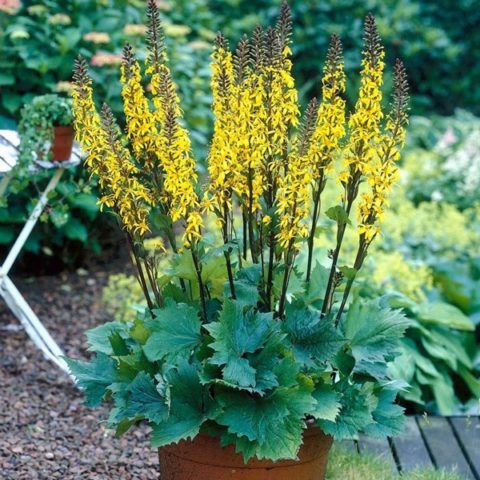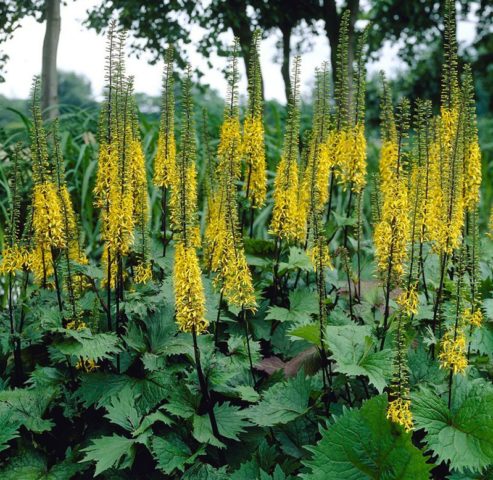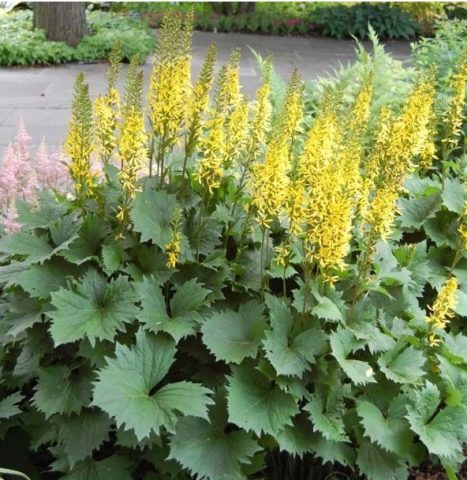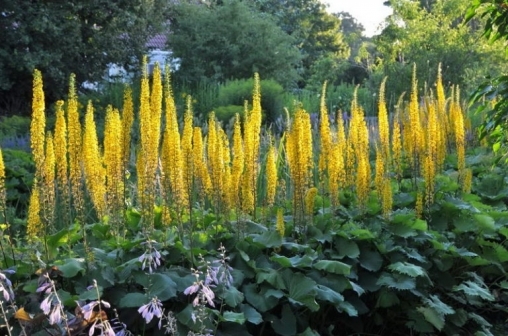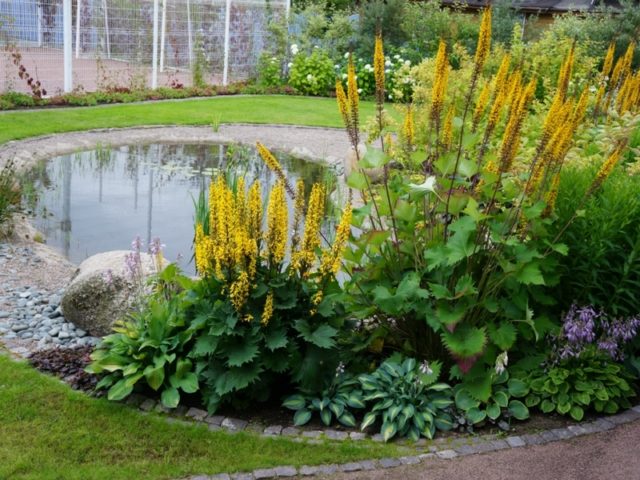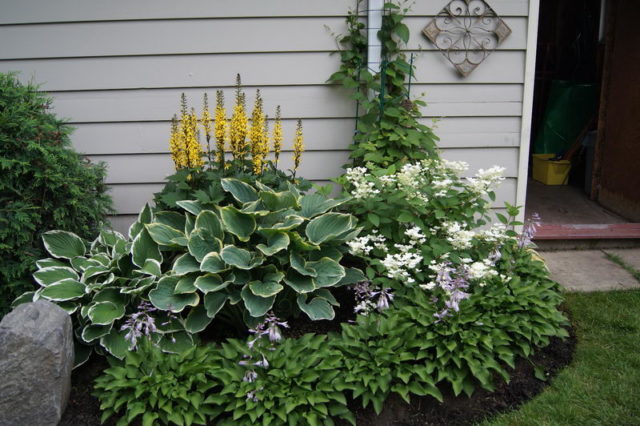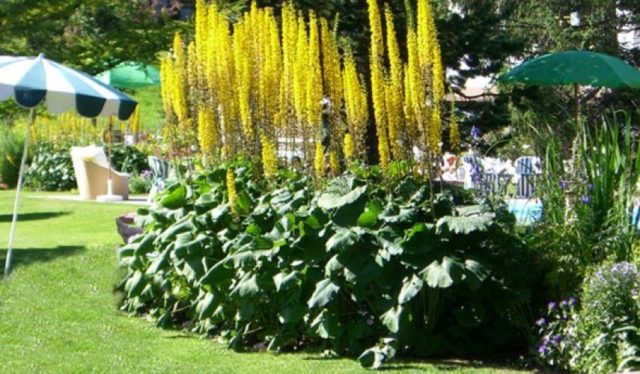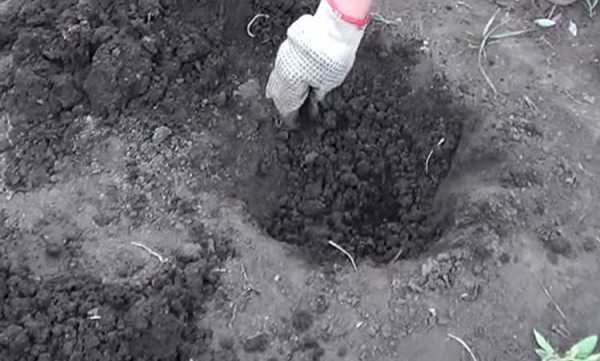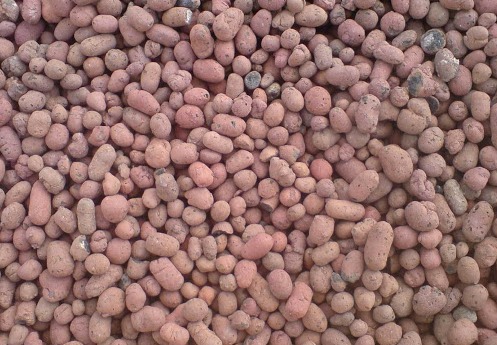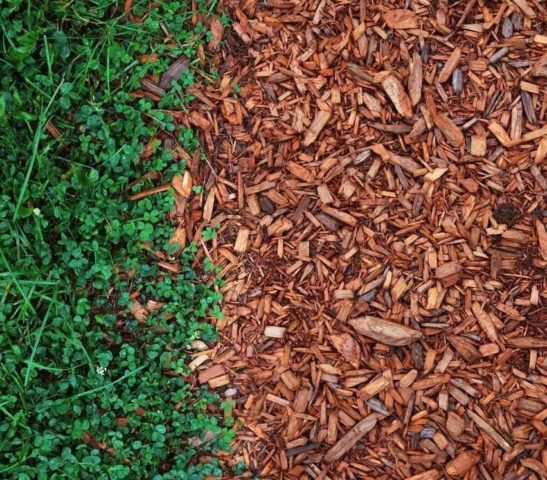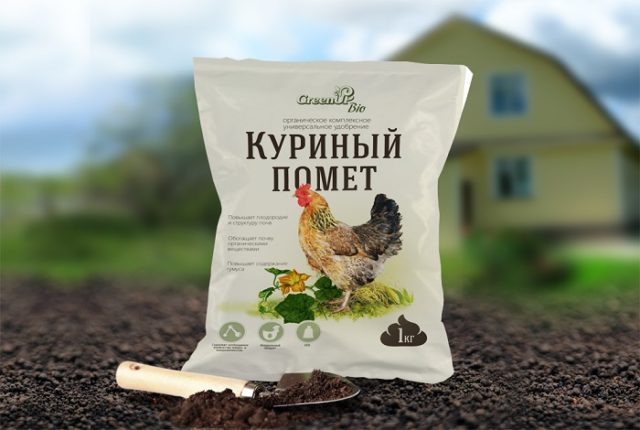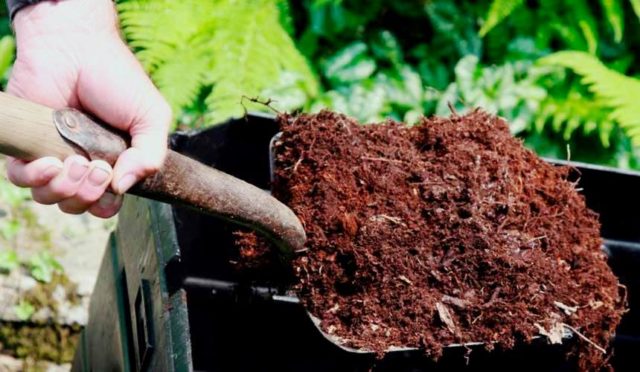Content
Buzulnik Raketa is one of the tallest varieties, reaching 150-180 cm in height. Differs in large yellow flowers, collected in ears. Suitable for planting in sunny and shady places. A characteristic feature - it blooms from July to the end of September.
Description of Buzulnik Raketa
Buzulnik Raketa (The Rocket, The Rocket) is one of the most beautiful hybrid varieties. It got its name thanks to the beautiful yellow flowers that gather in spike-shaped inflorescences up to 20 cm long (the total height of the bush is 150-180 cm). From a distance, they resemble beautiful yellow rockets. Spikes begin to appear in July, and flowering continues into September.
Rocket inflorescences always rise above the main part of the bush, so they are visually well defined. The yellow color is in harmony with the rich green in which the leaves are painted. They are heart-shaped, rather wide (15-20 cm). The leaves are pointed, with jagged edges. At the same time, the stems are very strong, they resist well even to strong winds. Shoots have a smooth dark brown surface.

Buzulnik Raketa is a winter-hardy variety that can withstand frosts down to -35 ° С
This variety can be grown not only in the middle lane, but also in the Urals and Siberia.
Rocket Buzulnik variety varieties
Buzulnik Raketa is represented by the following varieties:
- Buzulnik Little Rocket (Little Rocket) - hybrid, which is a small copy of the Rocket variety. The total height is 2-3 times lower - usually up to 60 cm. Produces yellow flowers, collected in ears. The leaves are large, dark green. In autumn, the foliage changes, changing color to burgundy.
- The Rocket variety is bred on the basis of an unattractive natural narrow-headed Buzulnik. The selection type Raketa is distinguished by beautiful carved leaves, reminiscent of grape or maple leaves. In autumn, their color changes from green to purple, which also makes the plant decorative even in the absence of inflorescences. The height of the culture is significant - up to 1.8 m.
Application in landscape design
Buzulnik Rocket is a very large, attractive shrub that is often used in single plantings. The Raketa variety looks good in the background of a flower garden, on an open lawn and under powerful trees. It revives abandoned areas, creates a kind of centers of attraction.
Several interesting options with a photo of using Buzulnik Raketa in landscape design will help transform any site:
- Single boarding next to the road. The plant will not only delight the eye with bright colors, but also protect the house from dust.
- Planting buzulnik in rows (hedge). With culture, you can create the appearance of a fence or fence off your garden recreation area.
- Buzulnik Raketa looks spectacular on the coast of a small reservoir. This planting is doubly beneficial: the plant will be lush, but additional watering is not required.
- Rocket variety can be used in composition with hosts and other ornamental plants. The flowerbed must be collected according to the height of the crops planned for planting.
- Buzulnik Rocket on the lawn. Culture will enliven the territory with its bright ears.
Breeding features
Buzulnik Rocket can be propagated by seeds and dividing the bush.Seeds are harvested independently from inflorescences (at the end of September) or purchased in a store. They are dried, and then (in October) planted before winter to a depth of 2 cm. It is not necessary to cover the Raketa variety - the seeds will undergo stratification in natural conditions. The first shoots of Buzulnik will appear in the middle of next spring. And they can be transplanted to a permanent place in August.
The seed breeding method of the buzulnik is quite effective, but laborious. New plants may not inherit parental qualities. Therefore, Buzulnik Raketa is often propagated by dividing an adult bush (at the age of at least 5 years). In early spring, it is dug up and cut into several divisions (each should have 2-3 healthy shoots). Then they are transplanted to a permanent place.
Planting and leaving
Buzulnik Raketa is easy to plant and breed, as it is an unpretentious plant. The bush takes root successfully even in strong shade and requires only minimal maintenance.
Recommended timing
There are two landing dates for the Raketa buzulnik:
- In spring - late April or early May.
- In autumn - in the last days of September or in the first decade of October.
Experienced summer residents often stop at the spring planting, since the seedlings will have time to take root during the warm season, and then winter well. In the southern regions, you can also choose an autumn planting.
Site selection and soil preparation
It is advisable to land Buzulnik Rocket in partial shade. Although it can grow well even in an open area or in shade (for example, under a tree or shrub). When choosing a place, pay attention to several points:
- The site should not be located in a lowland, where moisture constantly accumulates.
- If possible, the area should be protected from constant drafts.
- They also pay attention to decorativeness: the Raketa buzulnik can be planted next to the house, recreation areas, in a separate place (at some distance from the flower garden).
The site is cleaned and necessarily dug up - the plant loves loosened soil. If the land is infertile, apply a complex mineral fertilizer of 50-60 g per 1 m2.
Landing algorithm
Planting a Buzulnik Rocket is not difficult. Sequencing:
- Several sufficiently deep holes are formed on the site (the rhizome should fit completely). Maintain a distance of 1-1.5 m between neighboring plants. Although you can plant them at intervals of 80 cm to create a beautiful green hedge.
- A small layer of drainage (5-7 cm) is laid, consisting of small stones, pebbles, broken brick.
- The seedling is rooted.
- Sprinkle with earth so that the growth buds remain on the surface.
- Lightly compact the soil and watered abundantly.
- Mulch with peat, humus, sawdust or other materials.
Watering and feeding schedule
Buzulnik Raketa belongs to moisture-loving plants. Therefore, watering should be regular and abundant, but the soil should not be overly moistened. In the usual case (light rains), watered once a week. If drought is established - 2 times. If it rains periodically outside, additional moisture is not needed. The water should be warm and settled.
If the soil is depleted, and no fertilizers were added to it during digging, then a tablespoon of superphosphate and potassium salt should be sealed into the planting pit. In the future, they begin to feed from the next season:
- In the spring, they give liquid organic matter - an infusion of mullein, a solution of bird droppings or slurry.
- In mid-August, when the bloom of the Raketa buzulnik begins to decline, humus is introduced.
Loosening and mulching
Like many other flowers, Raketa Buzulnik prefers light soil. Therefore, it is advisable to loosen the soil before each watering, several times a month. To keep the ground moist longer, a layer of mulch is laid on it (peat, humus, spruce branches, hay, straw).You should also periodically weed the trunk circle so that weeds do not take away water and nutrients from the main crop.
Pruning
Pruning is carried out 2-3 times a year (depending on the region):
- In the spring, remove all damaged branches.
- At the end of summer, wilted flower stalks are cut off.
- In autumn, Buzulnik Raketa is pruned only in areas with severe winters. It is necessary to carry out a total pruning under the stump, leaving 4-5 cm above the ground.
Preparing for winter
In the south, the buzulnik may not be prepared for winter, i.e. do not even mulch or cover with fiber. In the middle lane, it is recommended to spud the bush.

If the winter may turn out to be too harsh (below -25 ° C), carry out total pruning and mulch with a high layer of fallen leaves, spruce branches, straw
In the Urals and Siberia, in the fall, they must carry out a complete pruning of the branches of the Raketa buzulnik, mulch and cover them with burlap or spunbond on top. Fix the edges to the ground with heavy stones.
Diseases and pests
Buzulnik Raketa rarely suffers from diseases, but sometimes a whitish bloom may appear on the bushes - powdery mildew. To prevent this from happening, as a preventive measure, the plant is treated with any fungicide:
- Fundazol;
- "Topaz";
- "Speed";
- "Profit";
- "Maksim";
- bordeaux liquid.
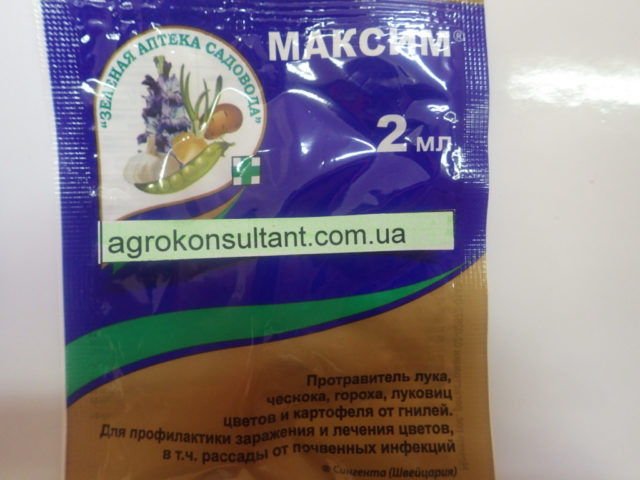
When the first signs of the disease are detected, chemical preparations are used
Nobody threatens the buzulnik from insects. But slugs (molluscs) pose a certain danger. To cope with their invasion, small stones, needles, walnut shells or chicken eggs can be poured around the plantings (you must first grind). With a small number of slugs on the site, they can be collected by hand.
Conclusion
Buzulnik Raketa fits well into any design idea. This is an unpretentious plant that only needs regular watering and loosening of the soil. With the right care, the culture will delight with lush, showy flowers that rush to the sky. It is most convenient to breed a variety by dividing an adult plant. The seed method does not guarantee the preservation of the decorative qualities of the culture.
